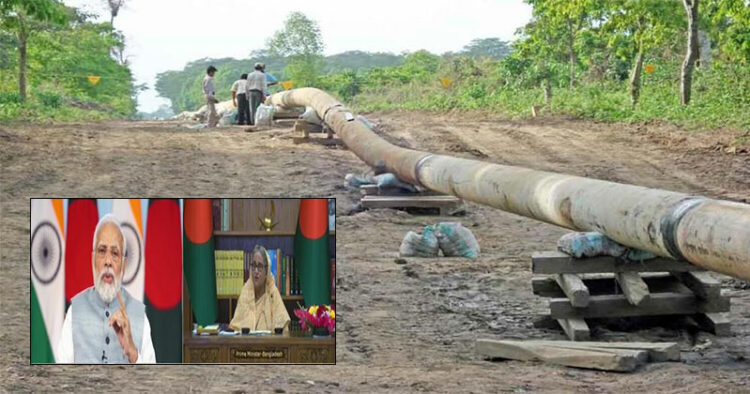With the inauguration of the India-Bangladesh Friendship Pipeline (IBFP) for diesel supply from India to Bangladesh’s northern district on March 18, bilateral relations between the Countries have reached a new height.
The first pipeline in South Asia will make Bangladesh’s diesel import more cost-effective and secure. While inaugurating the pipeline jointly with Prime Minister Sheikh Hasina, Indian Prime Minister Narendra Modi rightly termed the pipeline a reflection of Bangabandhu’s vision of friendship.
In recent years, the marked improvement of Bangladesh-India ties has manifested itself in numerous ways, such as increased connectivity, economic and energy cooperation and people-to-people contacts. A new major development in bilateral ties between the two friendly Countries has come in the energy sector. The pipeline is an example of how neighbouring Countries can support each other and contribute to each other’s growth and prosperity.
According to the report, construction of the pipeline which began in early 2020, has already been completed, and the facility is now ready to be commissioned to carry gasoil from India. The pipeline stretches 125 km through Bangladesh and 5 km through India passing through Panchagarh, Niphamari and Dinajpur to the Parbatipur oil storage facility in Bangladesh. Built at around 350 crore Indian rupees, the pipeline is expected to improve gasoil import and transportation from India dramatically.
Bangladesh imports around 2,000 tonnes of 0.005 per cent gas oil per month from India’s Numaligargh Refinery via Siliguri of West Bengal by railway. The oil reaches the Parbatipur oil depot by railway.
Once the cross-border pipeline is in operation, Bangladesh will no longer need to import gas oil by railway, reducing the import cost.
We hope it will usher in a new phase in bilateral cooperation between the two countries, and both countries will be benefited from this facility.
In this era of global interconnectivity, no country can prosper from isolation. India and Bangladesh share a vision of moving forward based on the principle that the potential in the South Asian regions will have to be harnessed together. Indeed, there are no two ways about it.
At a crucial juncture of an energy crisis, the much-awaited oil pipeline was formally inaugurated jointly through video conferencing by Bangladesh Prime Minister Sheikh Hasina and her Indian counterpart Narendra Modi on March 18.
At the inaugural ceremony, Sheikh Hasina and Narendra Modi said the Bangladesh-India Friendship Pipeline would “enhance cooperation in energy security” between the two countries.
The Indian Prime Minister said, “I am confident that this pipeline will further speed up the development of Bangladesh and be an excellent example of the increasing connectivity between both the countries.”
Terming the India-Bangladesh Friendship Pipeline as ground-breaking in Bangladesh’s energy history, Sheikh Hasina said, “When many countries are on the verge of [a] fuel crisis due to the Russia-Ukraine war at that time this pipeline will play a vital role in ensuring fuel security of our people.”
The first cross-border international oil pipeline is yet another landmark in the development partnership with neighbouring India.
According to officials of Bangladesh Petroleum Corporation (BPC), India would export high-speed diesel (HSD) through the 131.57 km India -Bangladesh Friendship Pipeline (IBFPL) project, built at the cost of around IRS 3.77 billion drawn from the Indian line of credit (LoC). Indian loan includes IRS 2.85 billion to construct a pipeline inside Bangladesh territory.
The Bangladesh-India Friendship Pipeline will implement a sustainable, reliable, cost-effective and environment-friendly mode of transporting HSD from India to Bangladesh, an official of the Indian Ministry of External Affairs observed.
The project will enable high-speed diesel to be exported from India’s Siliguri Marketing Terminal in West Bengal State to Bangladesh’s Parbatipur in Dinajpur.
High-speed diesel will be flowing from the Numaligarh Refinery Limited distribution terminal for testing of the pipeline from March 8, according to ABM Azad, chairman of BPC, the state fuel importer and distributor.
The pipeline stretches 125 km inside Bangladesh territory and 5 km inside India. The two prime ministers joined the ground-breaking ceremony for the IBFPL in September 2018 through video conferencing.
The construction of the pipeline project began in March 2020 and had a deadline for completion by June 2022. Due to the COVID-19 pandemic, the trial and test of the oil supply through the pipeline were delayed.
The HSD transmission will augment fossil energy-starved northern Bangladesh. The pipeline will ensure uninterrupted, fast and affordable means to 16 districts in the region, which needs nearly one million tonnes of fuel annually.
Bangladesh imported diesel from India through railway carriages, which were time-consuming and hassle to unload, store and distribute manually. The pipeline will significantly reduce its transport costs for Bangladesh, officials said.
According to the Dhaka-Delhi 15-year agreement, India will export 200,000 tonnes of oil annually in the first three years, 300,000 tonnes per annum in the next three years, 500,000 tonnes annually in the next four years and 1 million tonnes annually in the first phase. The second term would be extended based on the consensus of the countries.
Last year, Bangladesh imported six million tonnes of petrol, octane, and diesel. Diesel alone accounted for 75 per cent of fuel oils – 80 per cent of which is met through direct imports, according to a report published last year.
Bangladesh pays $11 in premium per barrel of fuel purchased from the international market, while the premium will be $5.5 per barrel in the pipeline project. “It means we will be able to save around $6 per barrel in premium,” the BPC official said.
An energy expert said that in the wake of a fuel crisis, the friendship oil pipeline project is expected to boost long-term business growth and bilateral ties between the two countries.




















Comments